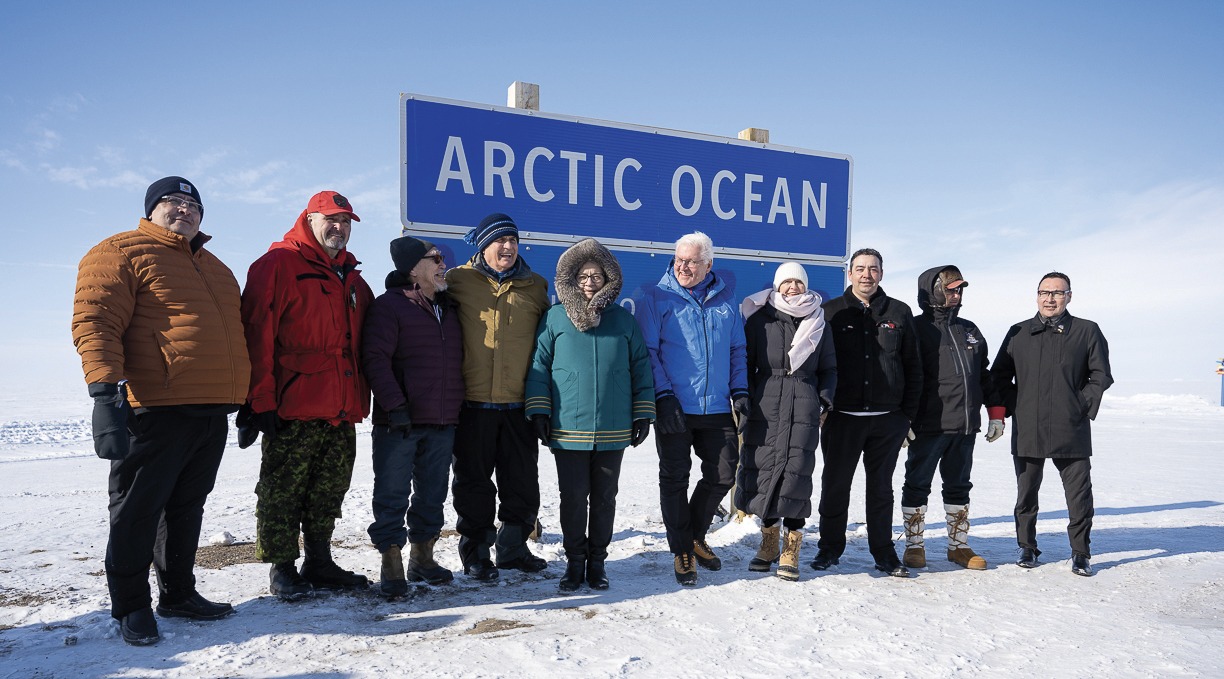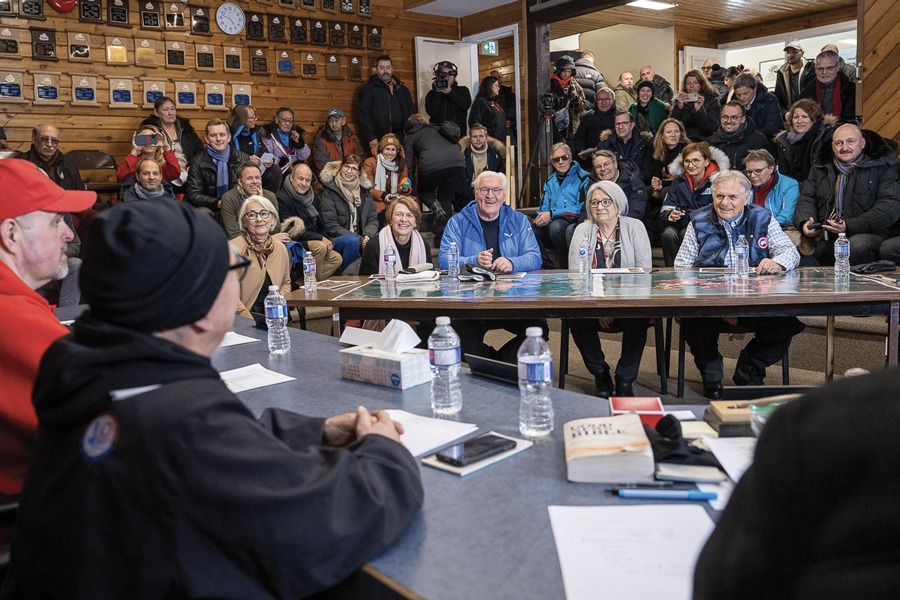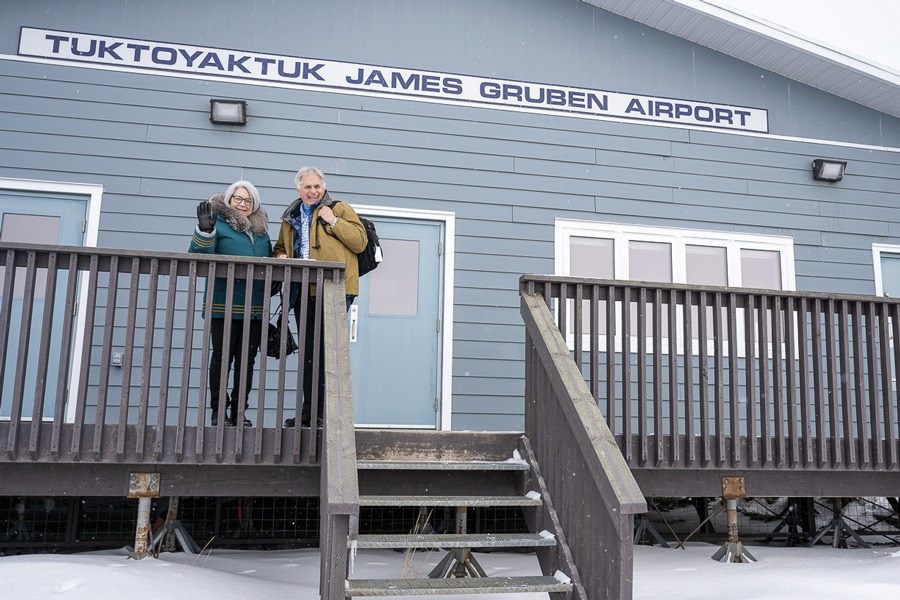This One’s for Tuk: With the German President on the Front Line of Climate Change

—MCpl Anis Assari, Rideau Hall © OSGG
Whit Fraser
In the Arctic, it’s always been the survival of the fittest, the fastest, or the smartest. In this new world, add the most politically astute, media savvy, connected and engaged. Consider the words of welcome to the President of Germany, Frank Walter Steinmeier from the mayor of Tuktoyaktuk — known locally as Tuk — an Inuvialuit community of just under a thousand on a barren gravel strip of disappearing land at the edge of the Beaufort Sea, during our visit in April.
“We want to welcome you, Mr. President,” said Mayor Erwin Elias, surrounded by his all-Inuit town council. Then, looking to the side of the crowded community hall, towards two dozen or more German and Canadian journalists and photographers, he added words the media throng rarely hear. “We especially welcome the press,” he said, explaining that the world needs to see the daily destruction of climate change, from rising temperatures to melting permafrost to coastal erosion. Then Mayor Elias set out the hard facts: Through windstorm after windstorm, crashing wave after crashing wave, Tuktoyaktuk is disappearing.
The German President’s Canadian visit was to develop and solidify Canadian-German partnerships in the changing energy-conscious economy. He brought with him a large delegation of German business leaders who were negotiating major investments in Canada’s green economy. Only a year earlier, when my better half, Canadian Governor-General Mary Simon, had visited Germany, President Steinmeier had expressed his lifelong wish to see Canada’s Arctic. The Steinmeiers’ smiles while standing on the frozen shore of the Beaufort Sea with the huge blue and white “Arctic Ocean” sign over their shoulders left no doubt this was an enormous thrill for both the president and his wife, First Lady Elke Büdenbender.

I would venture that of all the expertly crafted briefings the German President or other world leaders may have heard in recent years about the threat of climate change and the need to transition away from fossil fuels, few would make the point more effectively than Mayor Elias and his community. Using colorful maps and aerial photos projected on the wall and 8×12 handout photos for President Steinmeier, his host the Governor-General and every member of the approximately 50 heavyweights in the German delegation, the young mayor pointed to red lines on a blue background documenting, year over year, metre over metre, the disappearing shoreline. The mayor described the unique geography that comprises much of the Beaufort coast. It is not built on bedrock but rather permafrost. And the reality – what seemed so far-fetched seventy-five years ago, when people began moving here — is that the permafrost is melting rapidly, and as it melts, the surface sinks into the sea and oblivion.
There’s another reality. For the Inuvialuit, moving or relocating Tuk is not an option. A century and a half of transformation through imposed colonization, or “civilization”, has changed people. Inuit or Inuvialuit, as they are known in Canada’s western Arctic, are no longer nomads. Their nomadic existence started to disappear in the 1950s, when they began locating here, mostly from an ancient fishing and whaling camp called Kittigazuit, about 16 miles west at the mouth of the Mackenzie River.
The Tuk harbor area was and remains bountiful, with fish, beluga whales, and caribou. In the summer months, the coast is alive with waterfowl. Subsistence hunting remains a vital part of the local economy. In the 1950s, Tuk became a major component of the distant early warning radar system, or DEW line, that Canada and the United States built in locations from Baffin Island to Alaska to warn against a Soviet invasion. There were jobs in construction and maintaining the station, and for airport staff. In time, Tuk earned a character and personality as a community built upon the pillars of pride and perseverance. Today, it’s the 138-kilometre, two-lane gravel road connection with Inuvik and southern Canada that cements that character.
Tuktoyaktuk is adapting but the sea ice is no longer predictable; currents are changing and so is ice thickness. Travelling across the ice has never been more dangerous.
In the spirit of its good nature, a few were quick to remind me that Tuk is not the end of the Canadian road system, but rather the beginning. The new Arctic superhighway as some call it, also fulfilled a national Canadian dream since the 1960s; to have the nation connected by highway from sea to sea to sea. The old political dream gives new clout to the determined community. With three oceans finally connected, can we, as Canadians, sit back and watch a village of nearly one thousand people wash away with the melting permafrost?
I wrote before in this magazine that the joy of this new life as the Governor-General’s husband and tag-along is discovering how frequently my experience as a reporter finds relevance and connections with my new role. In Tuk, the old and the new are connected again. I never kept track of how many times I was here in the past. Maybe a dozen? Certainly, I have not had the opportunity to drive the new highway, but I’d like to. What I do remember is, more than once, the tremendous thrill of travelling along the old ice road out of Inuvik, down the east channel of the Mackenzie River, swinging right or east as the land began disappearing near Kittigazuit, where suddenly rather than a road over a frozen river, I was travelling at 90 km an hour over a frozen ocean road — a link that’s only good for about three months each year. I remember stopping once, where the wind had swept the snow away, leaving the ice polished smooth and so clear I could see down to the bottom but never knew how deep, 20 feet, 30 or more?

I was certainly in Tuk in the mid-seventies for many days when the community faced another threat, this one from the world’s major oil companies, which wanted to build what at that point was the world’s biggest and longest pipeline. Dozens of people, young and old, echoed the call that rang across the North during the now historic Mackenzie Valley Pipeline Inquiry chaired by Justice Thomas Berger : “Mr. Berger — there will be no pipeline until that land claims are settled.” I remember sitting late into the night in an older, even more crowded hall, with dense cigarette smoke, watching and listening to Inuvialuit hunters who knew the winds, waters, and ice of the Beaufort Sea, matching their knowledge against the highly educated oil company engineers. Those hunters and elders, now long deceased, pointed to places on their maps where historically huge ice jams gouged and tore at the shallow Beaufort Seabed and also indicated other places where the icepack was so powerful, it pushed massive icefields miles inland.
The inquiry is now a footnote in history, but Justice Berger did make unprecedented recommendations to protect the ocean environment against blowouts and oil spills and also called for a ten-year moratorium on a pipelines until the land claims were settled. Comforted in part by Berger’s recommendations, the community worked with the drilling companies for another decade, drilling and capping offshore oil and gas wells that have yet to be brought into production.
I remember sitting late into the night in an older, even more crowded hall, with dense cigarette smoke, watching and listening to Inuvialuit hunters who knew the winds, waters, and ice of the Beaufort Sea.
Today, when we were there in April, the mayor pointed to one body of water in the middle of the settlement, dangerously close to a series of small, ever-advancing inlets. “This is our water reservoir,” he said, “built and given to us by the oil companies.” He said if the beaches collapse in any number of locations, seawater will destroy the drinking water. Out in the harbor, an island that served as a natural breakwater is rapidly disappearing. The community has received federal government money to try and protect it. Missing is a detailed adaptation plan, which leaves Tuk in a critical situation. From a school bus, Mayor Elias showed the German president and others houses that had already been relocated, and more that looked as though they were almost sitting on the shore ice. Tuktoyaktuk is adapting but the sea ice is no longer predictable; currents are changing and so is ice thickness. Travelling across the ice has never been more dangerous.
The President and Governor General were given a demonstration of how new technology has become part of Arctic hunting gear.
The laptop fastened to the big qamutik (sled) looks remarkably out of place, until the hunter explains sonar sensors display ice thickness, water depth, currents and temperature. The hunter’s name was familiar to me: Nooksana, the grandson of Mark Nooksana, one of the wise elders who made such a convincing case all those years ago to protect against unregulated oil development. We all witnessed a magical moment with science and tradition in harmony — Mr. Nooksana’s thick, bare fingers seemed oblivious to the minus 15-degree cold and wind as he gently disconnected the laptop, put it in a case, casually picked up his walrus hide dog whip, and to the giddy joy of the media — particularly the Germans — mushed his team of a half-dozen huskies across the frozen ice, around the nearest point and out of sight.
Tuk always had a way of putting on a show and this — dear southern friends — is not the final act.
Whit Fraser, who spent years covering the North for the CBC, is an author and the husband of Canada’s Governor General.
